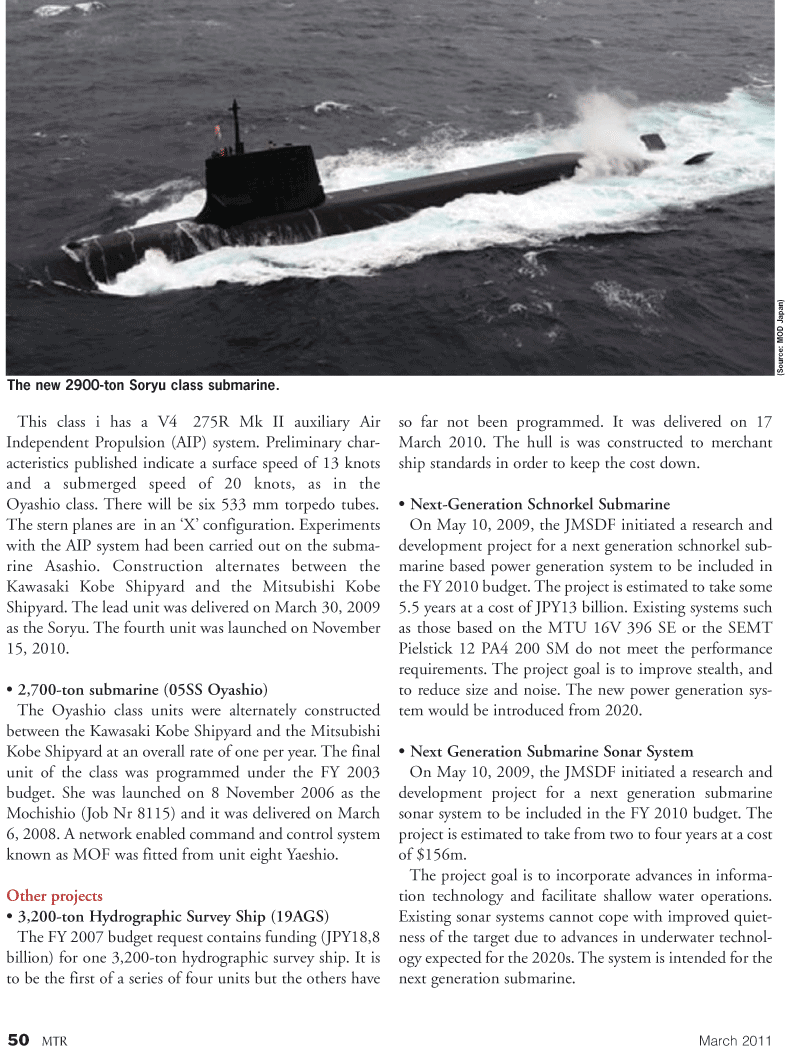
Page 50: of Marine Technology Magazine (March 2011)
Subsea Vehicles: AUV, ROV, UUV Annual
Read this page in Pdf, Flash or Html5 edition of March 2011 Marine Technology Magazine
This class i has a V4 275R Mk II auxiliary Air
Independent Propulsion (AIP) system. Preliminary char- acteristics published indicate a surface speed of 13 knots and a submerged speed of 20 knots, as in the
Oyashio class. There will be six 533 mm torpedo tubes.
The stern planes are in an ‘X’ configuration. Experiments with the AIP system had been carried out on the subma- rine Asashio. Construction alternates between the
Kawasaki Kobe Shipyard and the Mitsubishi Kobe
Shipyard. The lead unit was delivered on March 30, 2009 as the Soryu. The fourth unit was launched on November 15, 2010. • 2,700-ton submarine (05SS Oyashio)
The Oyashio class units were alternately constructed between the Kawasaki Kobe Shipyard and the Mitsubishi
Kobe Shipyard at an overall rate of one per year. The final unit of the class was programmed under the FY 2003 budget. She was launched on 8 November 2006 as the
Mochishio (Job Nr 8115) and it was delivered on March 6, 2008. A network enabled command and control system known as MOF was fitted from unit eight Yaeshio.
Other projects • 3,200-ton Hydrographic Survey Ship (19AGS)
The FY 2007 budget request contains funding (JPY18,8 billion) for one 3,200-ton hydrographic survey ship. It is to be the first of a series of four units but the others have so far not been programmed. It was delivered on 17
March 2010. The hull is was constructed to merchant ship standards in order to keep the cost down. • Next-Generation Schnorkel Submarine
On May 10, 2009, the JMSDF initiated a research and development project for a next generation schnorkel sub- marine based power generation system to be included in the FY 2010 budget. The project is estimated to take some 5.5 years at a cost of JPY13 billion. Existing systems such as those based on the MTU 16V 396 SE or the SEMT
Pielstick 12 PA4 200 SM do not meet the performance requirements. The project goal is to improve stealth, and to reduce size and noise. The new power generation sys- tem would be introduced from 2020. • Next Generation Submarine Sonar System
On May 10, 2009, the JMSDF initiated a research and development project for a next generation submarine sonar system to be included in the FY 2010 budget. The project is estimated to take from two to four years at a cost of $156m.
The project goal is to incorporate advances in informa- tion technology and facilitate shallow water operations.
Existing sonar systems cannot cope with improved quiet- ness of the target due to advances in underwater technol- ogy expected for the 2020s. The system is intended for the next generation submarine. 50 MTR March 2011
The new 2900-ton Soryu class submarine. (Sour ce: MOD Japan)

 49
49

 51
51
